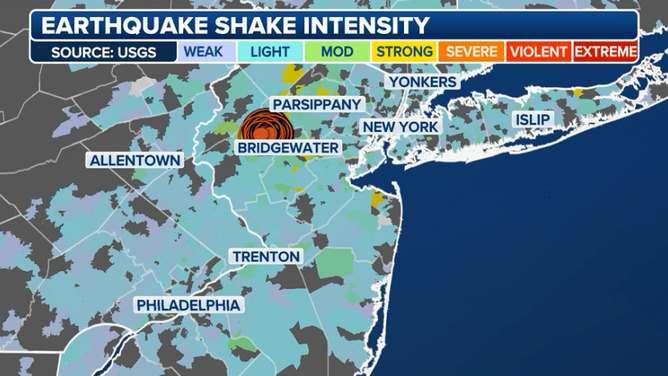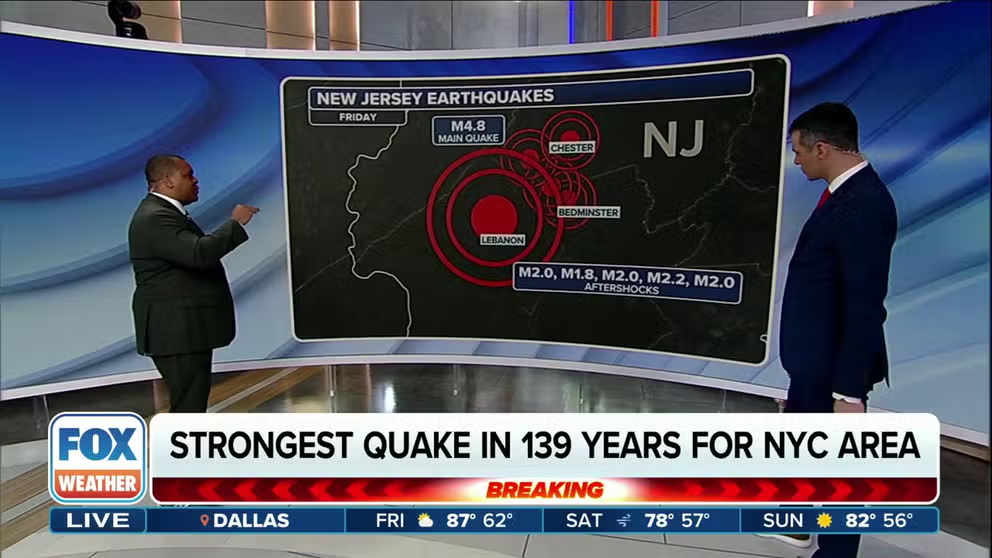More aftershocks likely in wake of historic Northeast quake, USGS says
As of Saturday afternoon, the USGS is giving a 60% probability of at least one more aftershock registering 3.0 magnitude or greater within the next week, with a 14% chance of a magnitude 4.0 or greater aftershock.
Strongest earthquake in 139 years shakes NYC metro
A 4.8 magnitude earthquake rattled New York City and the Tri-State on Friday morning.
NEW YORK — A day after a historic earthquake rattled much of the Northeast on Friday, the U.S. Geological Survey says the ground may not be done shaking.
The initial quake struck near Whitehouse Station, New Jersey, at 10:23 a.m. ET and measured at a 4.8 magnitude, ranking as the strongest quake to be centered in New Jersey since 1783.
The USGS estimates nearly 43 million people felt the quake as the shockwaves spread across New York City and the Northeast. People reported feeling the shaking from Maryland to Maine.
There were no reports of any significant damage or injuries.
Since the initial quake, more than a dozen aftershocks have been reported from or near the epicenter, with the greatest being a magnitude 3.8 around 6 p.m. — also felt across much of northern New Jersey and the New York City area.

(FOX Weather)
But the USGS says there may be more aftershocks in the coming days.
As of midday Saturday, the agency is giving a 60% probability of at least one more aftershock registering 3.0 magnitude or greater within the next week, with a 9% chance of a magnitude 4.0 or greater aftershock – odds that have dropped a little since Saturday morning when they were at 74% and 14% respectively. The probability rises to 84% of a 3.0 magnitude or greater aftershock by stretching the timescale to over the next month.
WHAT TO DO DURING AND AFTER AN EARTHQUAKE
However, there is only a 1% chance of a magnitude 5.0 or greater quake and fractional chances of a 6.0 quake or greater.
See how residents and animals react to the 4.8-magnitude earthquake in the Northeast
A 4.8-magnitude earthquake struck north-central New Jersey on Friday, but millions in more than a dozen states felt the ground shake.
"Basically, you never have just one earthquake," San Diego State Geologist Pat Abbott told FOX Weather. "Once the Earth has fractured in someplace and moved, that means it’s moved a lot of stress forward, which is going to cause adjoining areas to move as well."
WHAT ARE THE TYPES OF FAULTS AND HOW DO THEY RELATE TO EARTHQUAKES?
Abbott said he would expect the aftershocks to be weaker in magnitude.

A shake intensity map from the USGS from a 4.8 earthquake that hit New Jersey on April 5, 2024.
(FOX Weather)
"I would expect one or two aftershocks that you would feel," he said in the hours before the 3.8 aftershock rattled the region Friday evening. "It won't be as much damage, it won't be felt by as many people, but there will be more aftershocks."
The key to remaining safe during a quake if you're inside are three simple steps: drop, cover and hold on.
"That means DROP to the ground or lower your center of gravity, take COVER under a sturdy desk or table and COVER your neck and head with one arm, and HOLD ON to your cover with the other arm until the shaking stops," says Hollie Stark, Outreach Program Manager at the Washington Emergency Management Division. If your desk or table moves, move with it and stay there until the quake is over.
Abbott said that while a 4.8-magnitude quake may feel routine to those along the quake-prone West Coast, it would be felt over a wider area in the East.
EAST VS. WEST: WHY EARTHQUAKES ARE FELT DIFFERENTLY ON EITHER SIDE OF THE US
Mountains in the West are constantly being pushed up, leading to crushed rocks that don't transmit seismic energy as easily as those in the East, Abbott said. So, an earthquake of the same size in the East will be felt over a much wider area than in the West.

